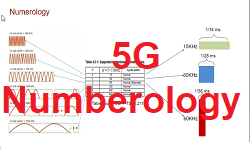5G NR User Plane Latency
The definition of user plane latency as per 3GPP TR 38.913, is “the time to successfully deliver an application layer
packet/message from the radio protocol L2/L3 SDU entering point to the radio protocol L 2/L3 SDU entering point via the radio interface in both uplink and downlink directions, where neither device nor Base Station reception is restricted by DRX.”
Or In other words, the user plane latency is analyzed as the radio interface latency from the time when transmitter
PDCP receives an IP packet to the time when receiver PDCP successfully receives the IP packet and delivers the packet to the upper layer.
The model to calculate user plane latency for LTE in FDD or TDD is shown in figure below. The same model can be applied for 5G user plane latency analysis, as the model this is very generic.

For FDD mode user latency calculation the following parameters are assumed. As per 3GPP RAN WG1 the subcarrier spacing can be considered as (15 kHz x 2^n) and the number of symbols for mini-slot (2 symbols). The same approach used for LTE can be reused in transmitter and receiver processing delay, i.e. same as TTI and HARQ Round Trip Time can be 6 or 8 TTIs (assuming 3 or 4 TTIs for HARQ feedback timing), this is considered just to make calculation simple, however 5G HARQ RTT will be much better.
- Subcarrier Spacing: 15 kHz, 60 kHz, etc.
- OFDM symbols per TTI: 2 for mini-slot
- Transmitter Processing Delay: same as TTI
- TTI: dependent on subcarrier spacing and number of symbols per TTI
- Receiver Processing Delay: same as TTI
- HARQ RTT: 6 or 8 TTIs (assuming 3 or 4 TTIs for HARQ feedback timing)
Table below shows overall user plane latency for LTE and two selected PHY configurations of NR in FDD frame structure.
NR-FDD- Configuration#1 assumes 15 kHz subcarrier spacing and 2-symbol TTI with 8 TTI HARQ RTT, which leads to 0.571 ms user plane latency without HARQ retransmission, and 0.685 ms with 10 % HARQ BLER.
NR-FDD Configuration#2 assumes 60 kHz subcarrier spacing, 2-symbol TTI with 6 TTI HARQ RTT that leads to 0.1429 ms and 0.1643 ms user plane latency with and without HARQ retransmission. For TDD, DL/UL configuration needs to be considered in addition to the parameters used for FDD. A configuration the same as LTE and enhanced configurations to support lower latency, such as repeated S-U sub-frames, can be considered as examples.
The number of OFDM symbols per TTI also needs further consideration, as the 2-symbol mini-slot that is used for FDD may not be optimal for TDD, considering additional DL/UL switching overhead. The agreement for latency reduction in release 14 introduced, 7 symbols per TTI-can be used as the starting point.
- OFDM symbols per TTI: 7 (slot) or less
- DL/UL configuration: same as LTE, repeated S-U, etc.
Overall user plane latency for LTE and two selected TDD configurations, NR-TDD- configuration#1 assumes 15 kHz subcarrier spacing and 7-symbol TTI with a DL/UL configuration the same as LTE TDD configuration #6, which leads to 3.075 ms and 2.775 ms user plane latency for downlink and uplink respectively without HARQ retransmission, and 3.54 ms downlink and 3.2575 ms uplink with 10 % HARQ BLER.
NR-TDD-2 configuration assumes 60 kHz subcarrier spacing, 4-symbol TTI with repeated S/U sub-frames, which leads to 0.3124 ms and 0.355 ms user plane latency with and without HARQ retransmission.
Reference:
- TR 23.799 Study on Architecture for Next Generation System
- TR 38.801 Study on New Radio Access Technology; Radio Access Architecture and Interfaces
- TR 38.804 Study on New Radio Access Technology; Radio Interface Protocol Aspects
- TR 38.913 Study on Scenarios and Requirements for Next Generation Access Technologies
- Samsung White Paper: 4G-5G Interwworking
- Techplayon: LTE Control Plane and User Plane Latency Calculation (FDD)
Related Post
- 5G NR Grant Free Dynamic Scheduling
- 5G NR sounding Reference Signal (SRS)
- 5G NR RACH Preamble Types: Long and Short Preambles
- NR-Logical Channels,Transport Channels and Physical Channels Mapping
- NR Radio Network Temporary Identifier (RNTI)




